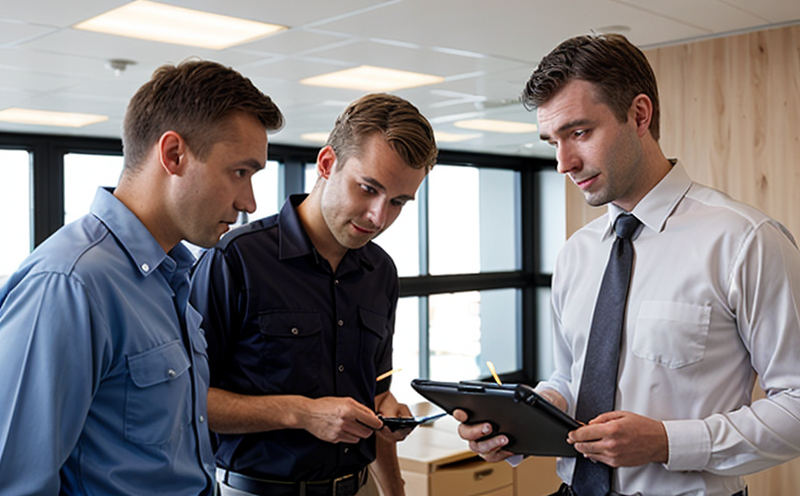Workplace lighting inspection
In today’s modern and dynamic work environments, ensuring that workplace lighting meets safety standards is paramount. Lighting plays a critical role in maintaining visibility, enhancing productivity, and promoting overall well-being for employees. A poorly lit workspace can lead to accidents, eye strain, and reduced performance, which underscores the need for thorough workplace lighting inspections. This service ensures that lighting systems comply with relevant standards such as ANSI/IESNA RP-25 and EN 12464, thereby safeguarding both workers and facilities.
Workplace lighting is not just about illuminating spaces; it involves a holistic approach to creating an environment that supports health and safety. The inspection process focuses on several key areas including luminance levels, uniformity, glare control, color rendering index (CRI), and flicker detection. Properly conducted inspections help in identifying hazards such as insufficient brightness or excessive brightness which can cause discomfort or accidents.
Lighting design impacts not only the physical safety but also the psychological well-being of individuals working within that environment. Studies have shown that employees who work under optimal lighting conditions experience less stress, better sleep patterns, and higher morale. By adhering to strict industry guidelines like those provided by the International Organization for Standardization (ISO) and National Electrical Manufacturers Association (NEMA), we ensure that our inspections are not only compliant but also effective in improving workplace safety.
The importance of regular lighting inspections cannot be overstated. They serve as a proactive measure against potential hazards, contributing significantly to accident prevention and injury reduction. Moreover, these inspections help organizations comply with local regulations and codes which vary by jurisdiction, ensuring that all aspects of the facility meet legal requirements.
- Improved Safety: Reduced risk of accidents due to poor visibility.
- Elevated Productivity: Enhanced performance levels resulting from better working conditions.
- Better Employee Satisfaction: Comfortable and healthy environments lead to higher job satisfaction rates.
In summary, a comprehensive workplace lighting inspection is more than just checking bulbs or switches. It encompasses a detailed evaluation of the entire lighting system to ensure it meets all necessary criteria for safety, comfort, and efficiency.
Applied Standards
The standards applied in workplace lighting inspections are critical for ensuring that the lighting systems meet both regulatory requirements and industry best practices. One of the primary standards used is ANSI/IESNA RP-25, which provides guidelines on how to measure and evaluate indoor lighting conditions. This standard focuses on parameters such as illuminance, color temperature, and uniformity, all of which are essential for creating a safe and productive work environment.
Another important standard is EN 12464, which specifies the methods for measuring luminaire efficiency and its impact on energy consumption. By adhering to these standards, we ensure that the lighting systems used in various sectors—such as manufacturing plants, offices, warehouses—are not only safe but also environmentally friendly.
For those concerned with color quality, ISO 22432 comes into play. This standard sets out criteria for evaluating the color appearance of light sources, which is crucial when selecting lighting that provides accurate color rendering in specific applications like art galleries or medical settings.
Additionally, NFPA 70 and IEC 61985 are relevant to electrical safety aspects, ensuring that all components used in workplace lighting are safe from the risk of fire hazards. Compliance with these standards ensures not only protection against electrical faults but also extends to the overall integrity of the facility.
By leveraging international standards like ISO and ASTM, we provide clients with a robust framework for assessing their current lighting systems while identifying areas for improvement. Our expertise lies in translating complex technical specifications into actionable insights that can be used by quality managers, compliance officers, R&D engineers, and procurement professionals alike.
Scope and Methodology
The scope of a workplace lighting inspection is broad and encompasses multiple facets to ensure that every aspect of the lighting system contributes positively to employee safety and comfort. The first step involves conducting an initial assessment where we gather data on existing lighting conditions through surveys, observations, and measurements using advanced tools like photometers and illuminance meters.
Following this evaluation, detailed testing is carried out to assess various parameters such as luminance levels, glare indices, color rendering indices (CRI), and flicker rates. These tests are conducted in accordance with established standards mentioned earlier to guarantee accuracy and reliability of results. For instance, when measuring illuminance, we follow the procedures outlined in ANSI/IESNA RP-25 ensuring that all readings reflect real-world conditions accurately.
A critical part of our methodology involves assessing the psychological impact of lighting on employees. This includes evaluating how different color temperatures affect mood and concentration levels during working hours. Understanding these nuances helps us recommend optimal settings that enhance both physical safety and mental well-being within the workplace.
Furthermore, we conduct comprehensive audits to identify any non-compliance issues with local regulations or company policies regarding lighting usage. Our team works closely with clients throughout this process to ensure they understand each finding and recommended action clearly. This collaborative approach ensures that corrective measures are implemented effectively without disrupting daily operations unnecessarily.
The methodology also includes a review of existing documentation related to lighting installations, including design plans, installation manuals, maintenance logs, etc., providing us with valuable insights into past decisions made regarding the lighting system. By analyzing this data alongside current findings from our inspections, we can determine trends over time and make informed recommendations for future improvements.
In conclusion, through meticulous planning and execution of each inspection process, we deliver thorough evaluations that address all relevant aspects of workplace lighting. Our goal is to provide clients with actionable recommendations aimed at enhancing safety, efficiency, and comfort within their facilities.





